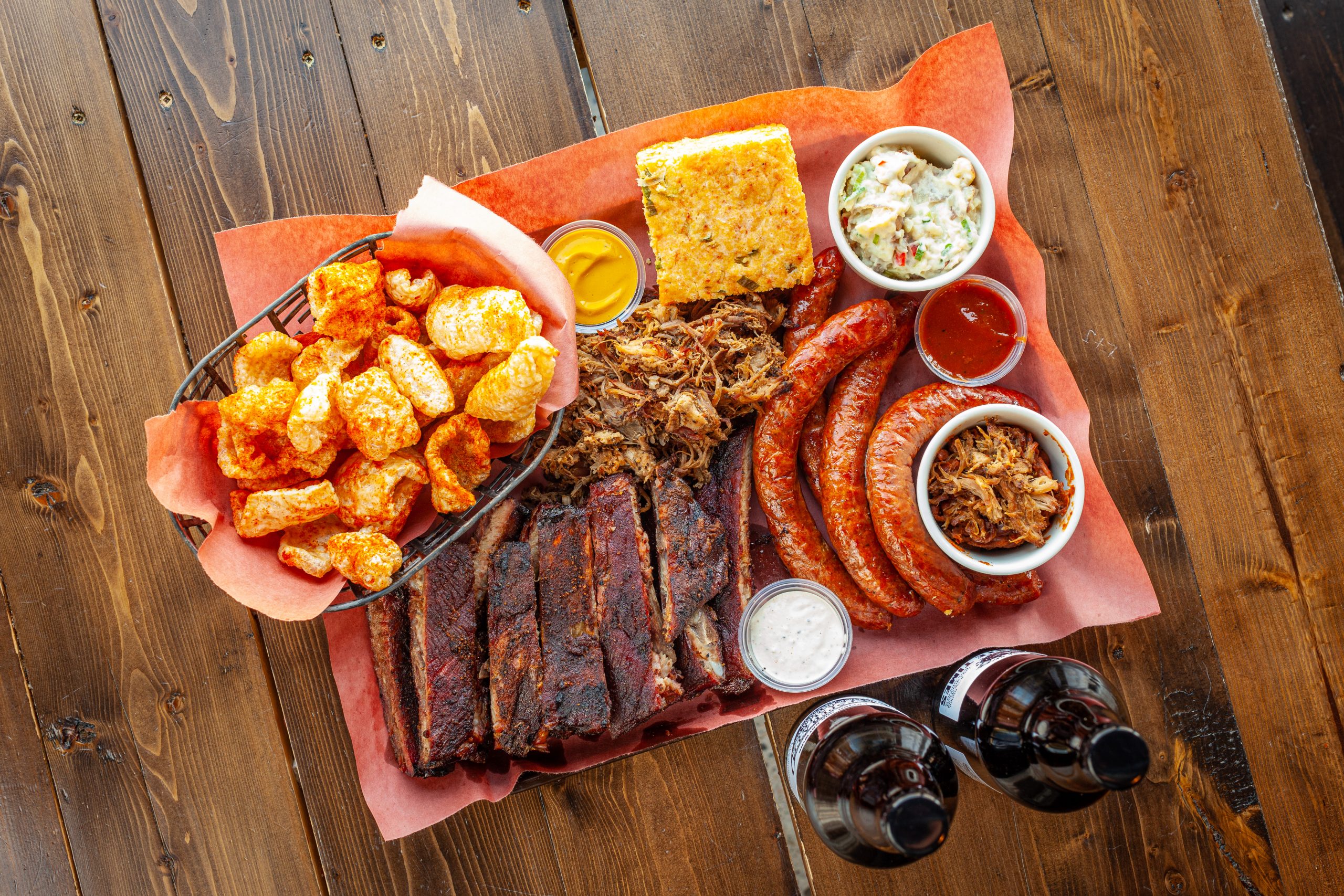Prairie Dog Brewing closed our doors to in-house dining (dine-in) after March 17, 2020 (St. Patrick’s Day), when public fear and government mandated restrictions due to the COVID-19 pandemic made it impossible to maintain restaurant operations. After closing, we pivoted heavily into building our takeout and delivery lines of business, which went really well with the support of so many Calgarians, and allowed us to keep existing over the past 5 months, but that was all it was — existing, or maybe it would be better to say subsisting. Our loyal guests, employees, friends and followers have been asking when we will be reopening for in-house dining and getting back to what we love doing — providing our community with an awesome venue to gather, socialize, and (re)connect over some of Calgary’s best barbecue and craft microbrew beer. The time has come and we’re finally ready to share our space with you again. Here are the reasons why our calculated approach will be worth the wait!
Doors open to the public on Monday, August 24th, 2020.
COVID-19 Safety
We know that many of you might feel a little bit anxious when we use words like “gather”, “socialize”, and “connect”, which are suddenly discouraged in the midst of the current pandemic, but those of you who’ve been following us for a while know that we are very cautious and have carefully planned for how to overcome the major challenges involved in operating a restaurant right now. We feel confident that we can operate our dine-in restaurant while sufficiently mitigating the various risks to our staff, customers, and business to make ourselves comfortable.
Risk Mitigation Approaches
The complete details of what we’ve done over the past several months to prepare for reopening could literally fill a novel, but here are some of the highlights of what we’ve been doing to mitigate the various risks associated with reopening our restaurant for in-house dining during the pandemic, and some other important projects that we decided to undertake while we were closed.
Tier 1 Changes/Table Stakes
These are the types of changes that any restaurant should be doing anywhere in the world right now, and which were mandated by Alberta Health Services in guidelines prior to restaurant (re)openings in late May, so we hope you can’t find a restaurant that isn’t doing them (please don’t tell us if you do, that would just make us die a little inside).
We have:
- Ensured a minimum distance of 6′ (2m) between seated customers, which equates to about 8′ between tabletops, except where physical barriers are present up to a height of 6′ or more
- Required staff to wear masks if they must come within 2 metres of any other person for more than brief moments (see Tier 2 for our actual approach)
- Set up one-way traffic patterns throughout the restaurant and established 6′ aisles
- Limited table seating to groups no larger than 6 people
- Changed all our chemicals and procedures to ensure that they are actually effective against coronavirus (and Norovirus, since it’s another up-and-comer)
- Implemented new frequent disinfection schedules and checklists for all high-touch surfaces, and immediate disinfection of items such as payment terminals after customer usage
- Overhauled our table-flipping procedures and removed items that could be touched by multiple customers (such as menus, sauce bottles on tables)
- Added sanitizer stations throughout the building, staff health questionnaires at shift changes, signage, etc
Tier 2 Changes
These are the kinds of things that are harder to do, not necessarily due to cost, but because they require behavioural changes, time to implement, or create impediments to working.
- Although it is now recommended by AHS and became mandatory on August 1, 2020, we required universal, mandatory mask usage for all staff and owners of Prairie Dog Brewing as of May 20, 2020, even while we were shut for dine-in; this gave staff the opportunity to acclimate to mask usage and for us to learn and improve, they are now something we’re not even aware of most of the time, like a shirt or shoes
- Created the concept of “red” and “green” staff — the separation of duties between those who deal with contaminated items (such as used dishes, glasses, and napkins), and those who deal with “clean” items (such as plates of food and glasses of beer going out to the customer); this requires new job descriptions, hiring, procedures, equipment, and schedules, both in the front of house and kitchen
- Switched to online menus to eliminate waste and/or contamination between customers, even within the same party
- Switched to having a host for traffic control, and using a reservations system for booking during busy business hours to try to minimize crowding and lineups
Tier 3 Improvements
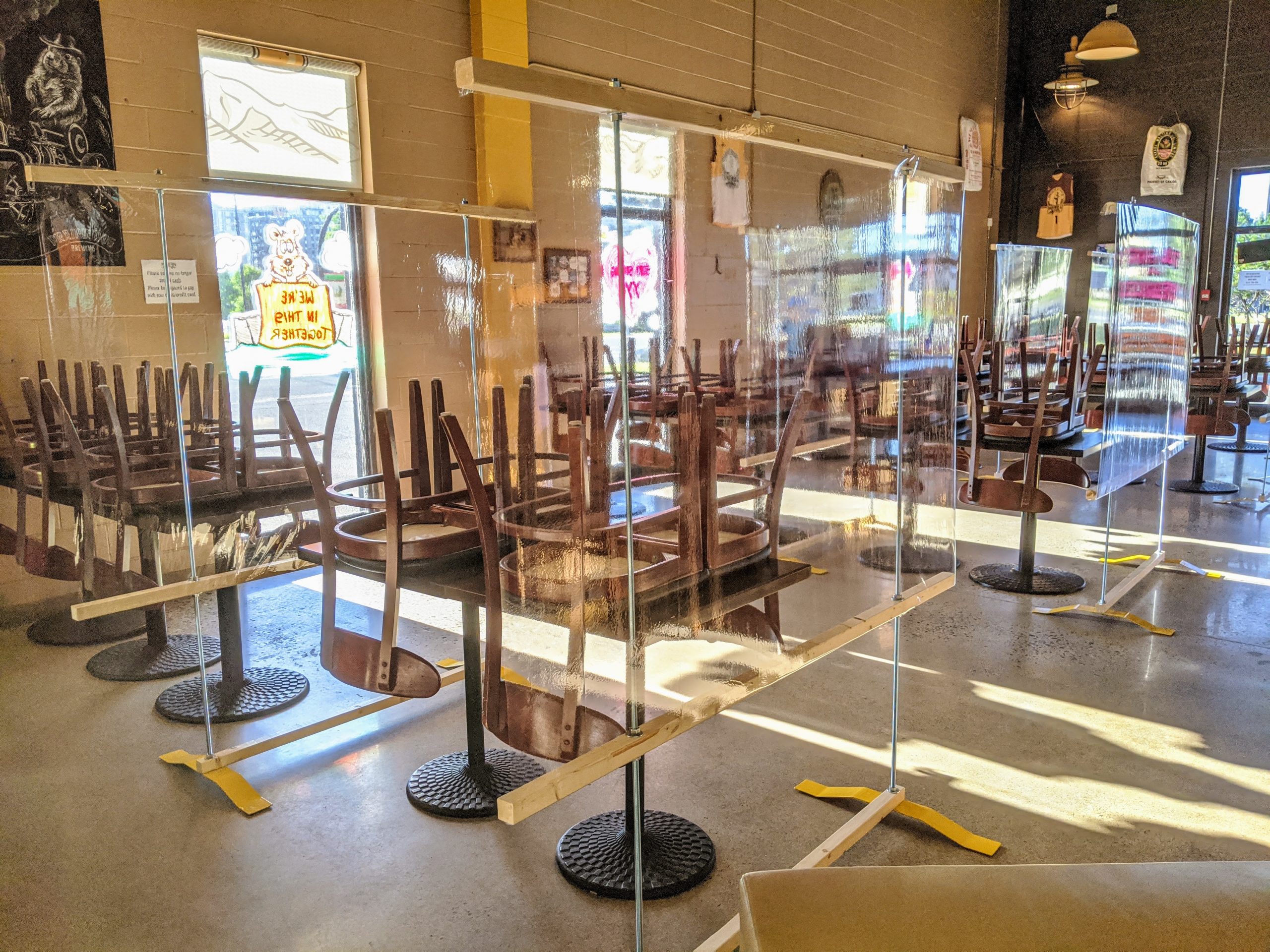
These improvements required a greater commitment of capital, time and energy, but we think they were worth it because they allowed us to stay truer to who we are and what we built Prairie Dog Brewing to do.
- We designed and built a ton of physical barriers to provide separation between tables and abutting aisles. See photo above
- We added a new hand-washing sink directly behind our bar in the dining room, with a foot pedal, so there is no excuse for staff not to wash their hands frequently
- We installed foot-pedal controls at all three of our kitchen hand-washing sinks to encourage more hand washing and minimize potential cross-contamination through faucet levers
- We built a new triple-wash-tub pre-soak station in our dish area, which is filled with a novel disinfectant/degreaser chemical that can kill coronavirus in 30 seconds; customer dishes soak in this station for a minimum of 10 minutes (by hourglass) before being handled by our dishwasher — this cuts down on the risk of aerosols and droplets infecting our kitchen staff because dishwashers no longer need to use a spray wand to clean the dishes before they go in our dish machine, and the dish surfaces and anything lifted by the degreaser will be disinfected before handling.
- We are working in the background on building a full online ordering system, which will allow guests to use their own mobile devices to order food to their table without having to interact with servers, reducing the amount of time servers spend in the airspace around guest tables (which is a protective measure for our staff, since their mask does very little to protect them from unmasked customers, and exposure time is a key factor in transmissibility)
Tier 3+ Bar Improvements
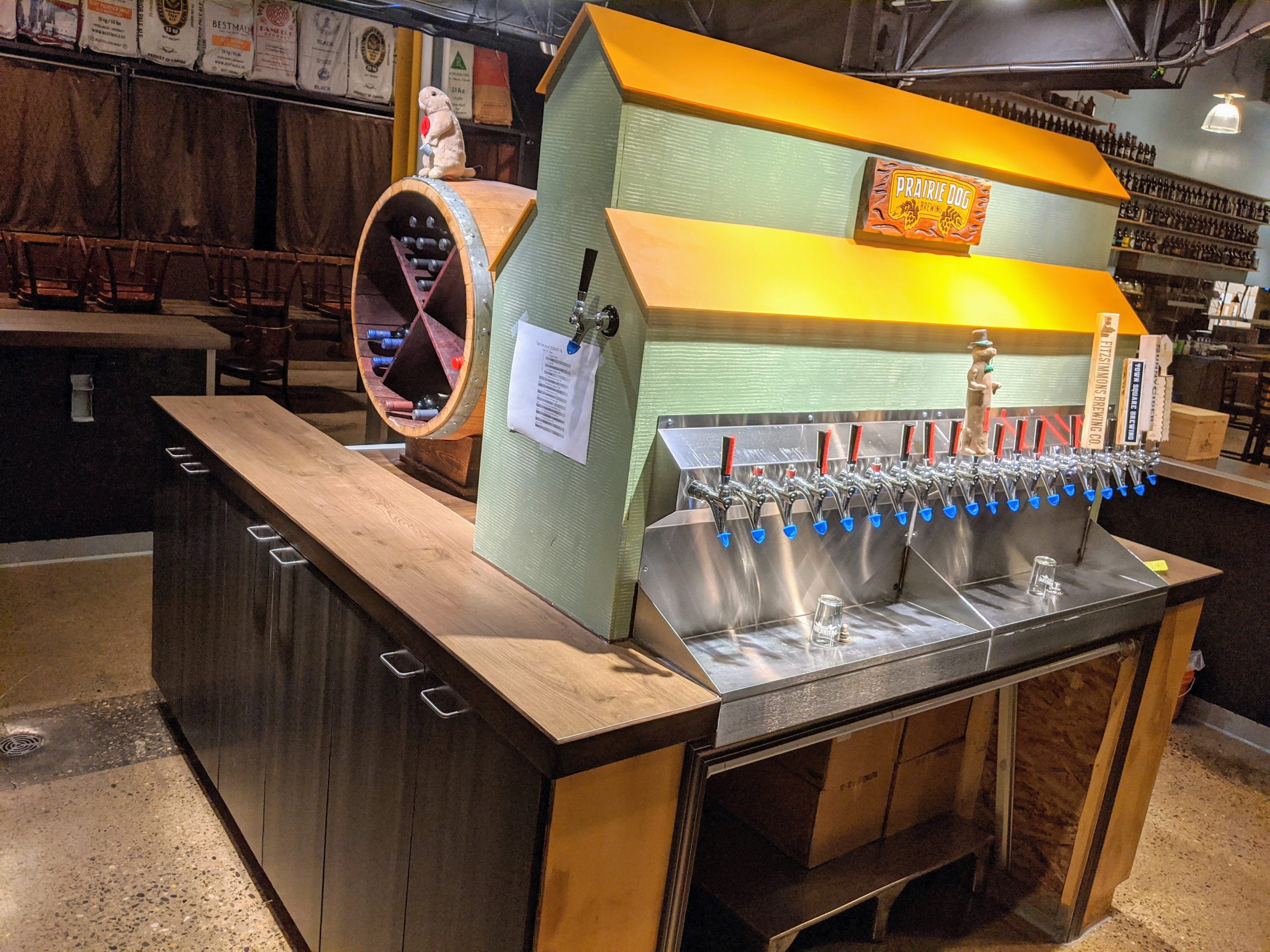
Our bar is a centrepiece to our dining room and operations — it is very important to us that guests are able to sit at the bar and imbibe as they always did in the past, but the AHS guidelines pretty much ruled out bar usage because all guests sitting at our “wood” were within 2 metres of all of our glassware, prep areas, ice well, etc. Our bar also had a few issues going back to construction that were making it difficult to keep clean and sanitary to our exceptionally-high standards. Therefore, we:
- Reorganized glassware management from the ground up:
- We moved all of our glassware into racks designed for caterers (Camracks), which are completely enclosed on the sides and have covers to keep out dust and other contaminates (such as viral particles settling out of the air)
- Eliminated the use of intermediary trays for storing both dirty and clean glassware before/after dish washing, removing an important point of potential cross-contamination of glassware through staff handling
- Relocated/reconfigured our bar glass washer units to place them both directly beside our dirty glassware drop-off area, cutting down on movement and handling of dirty items, and keeping washing activities in a single area
- Purchased covers for glass racks and set up a covered, sanitary drying station
- Built and installed cabinet doors for all our centre bar island cubby shelves, which house glassware, cocktail implements, liquor etc
- Removed our old cocktail stations, which included our ice wells and bar sinks, and replaced with a new dedicated (and importantly, covered) ice well and separate 3-compartment sink, which also includes a more sanitary system for chilling our fountain soda pop
- The 3-compartment sink gives us better options for hand washing, cleaning and sanitizing growlers, rinsing cocktail utensils, etc
- Designed and fabricated fixed plexiglass barriers for our cocktail prep area, drink pass area, etc
- Designed and fabricated mobile plexiglass barriers that we can place between customer groups to allow more seating around the bar
- Purchased a new cold water fill station (which hasn’t arrived yet, but we’ve got the plumbing ready to go for it), which replaces our old portable water station; it required bartenders to continually add ice and water by opening a lid, and had a faucet lever that required handling by staff (or the occasional customer that missed our signage), whereas the new one is a closed system with a sanitary lever actuated by the glass to be filled
- Resurfaced bar countertops in work areas to make them completely waterproof and easier to clean and disinfect
Tier 3++ Organizational Improvements
Although it isn’t something most people think about, storage is often a problem in restaurants. Floor plans are usually designed to maximize the square footage given to the dining room (for seats/revenue), with the kitchen getting a tiny fraction of the space, and storage being a total oversight. Our founder Jay had a big say in our design, so the kitchen actually got a decent amount of space, but we still forgot about storage, even for things like growler jugs, spare glassware, merchandise, etc.
Before we opened, we had many, many projects that we planned to undertake but never got time to do, so we’d been holding onto items from auctions, construction materials, tools, benches, chairs, coolers, etc with the hopes of eventually using them. We also had many appliances break on us over the past while, since so many of them were purchased used and had been shut off for a while when we closed for dine-in. Then there’s all the new takeout supplies we started bringing in after closing for dine-in, every different type of container, lid and bag comes in a large box or bundle.
This all led to a lot of systemic problems and general clutter in our back of house and brewery areas, which affected us both mentally and in terms of how we work, and created scenarios where safety, sanitation, distancing, efficiency or other best practices were compromised hundreds of times a day. So what better time than when we were already closed to undertake a massive cleanup project, including finishing off a lot of the planned projects and creating “places” for all of the items we actually wanted to keep.
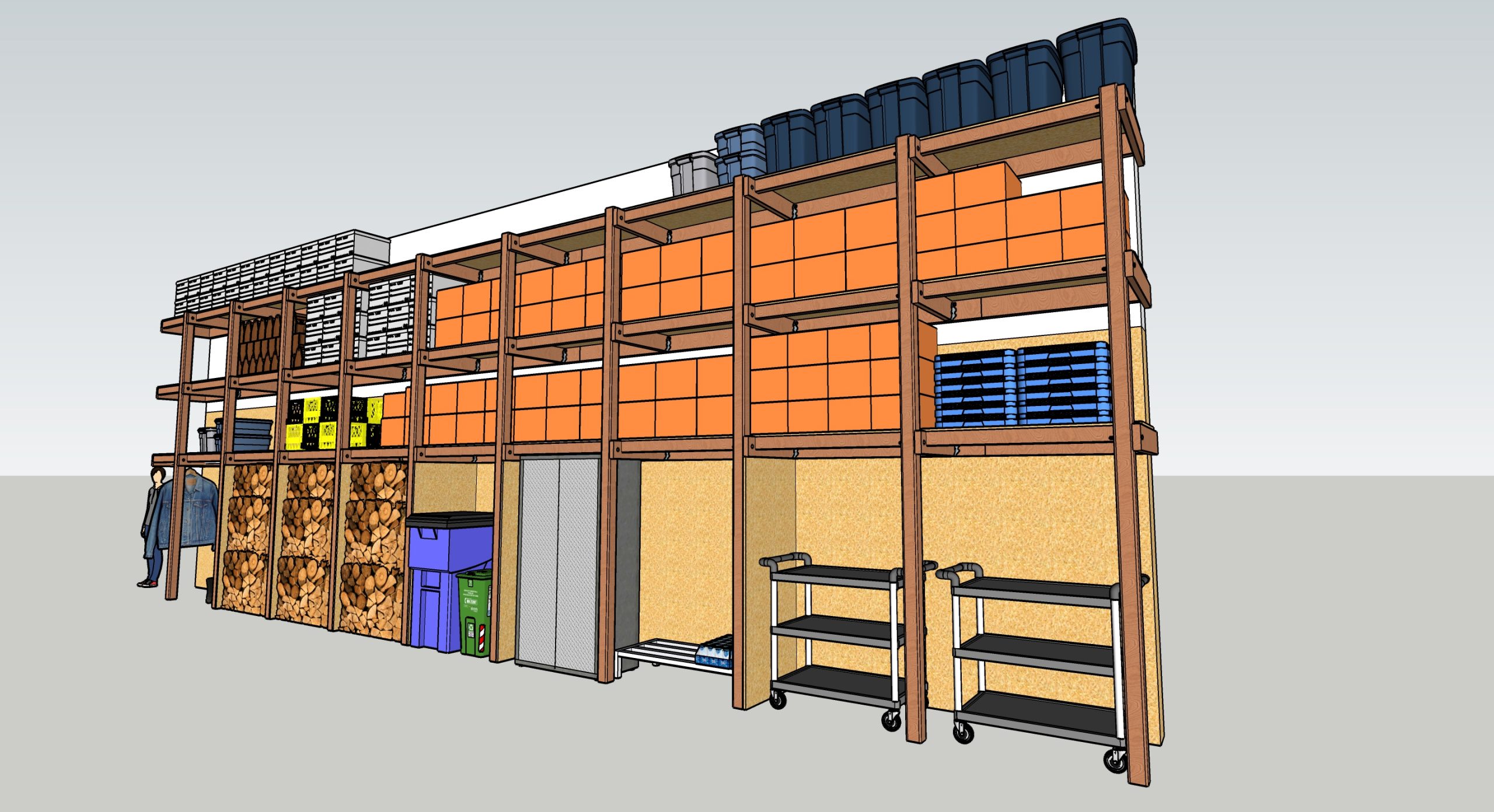
Enter, our storage shelving project, as shown above. We designed a three-tiered shelving system in SketchUp, which would be 38-feet long by 12-feet high, with shelving 2-feet deep, facilitating about 1,000-cubic-feet of organized storage, and easily customized for various situations. Then, we purchased the materials during a tornado under apocalypse clouds and built the shelving over the course of about two (long) days. Here’s how it looks now:
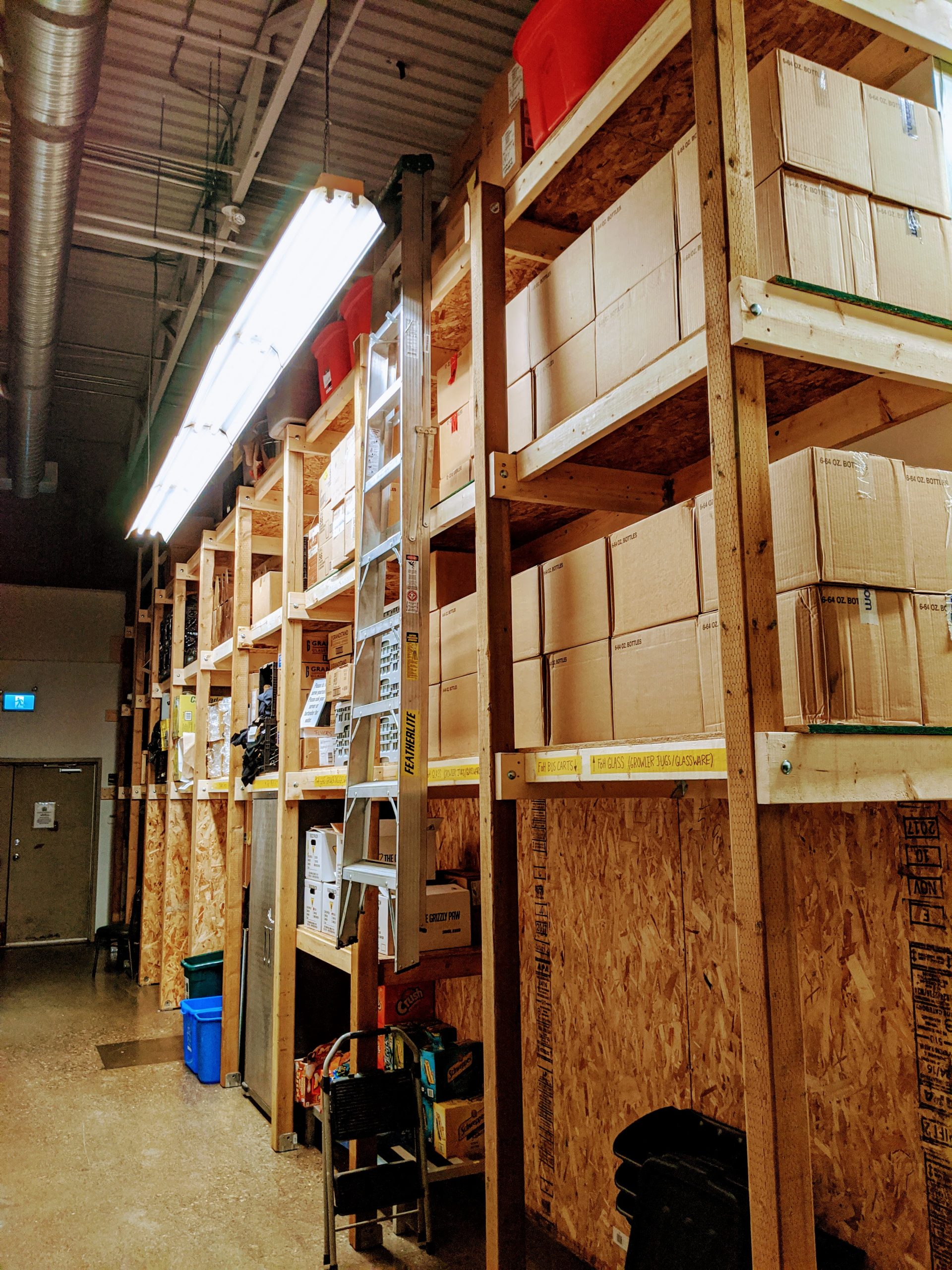
The storage shelving is now about 2/3rds full, but we filled it by going through all of the other storage areas and clutter in our building and selecting and reorganizing the few items we actually wanted to keep. This has had a domino effect, unlocking several other projects that were stalled and allowing us to completely rethink our space.
With the storage shelving in place and other areas reorganized, we turned our attention outside the rear of our building to our parking lot, which had stacks of pallets, old, broken coolers, chairs, benches and a big green sea can that we’d been holding onto for three years (and which was full of even more random stuff), though it was originally supposed to be a temporary measure until construction was completed.
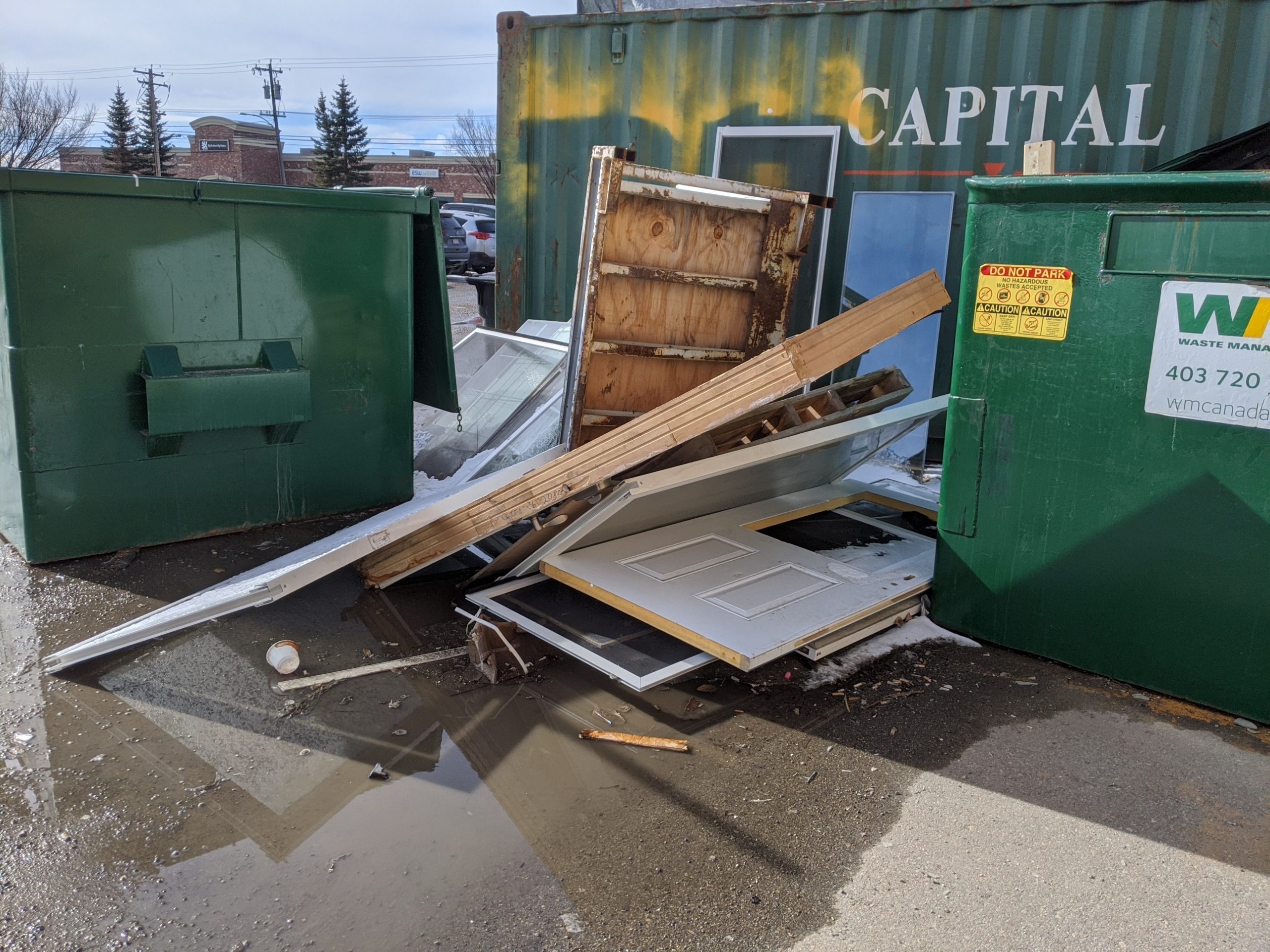
The area behind the sea can was a dangerous hot spot for addicts and other undesirable activities, and our neighbours were routinely storing broken glass and doors against our sea can. We brought in a 20-yard garbage bin, and placed items either on Kijiji or with a big “FREE” sign in our parking lot. Anything that didn’t get taken after a few days went into the bin. This worked amazingly well, saving us hundreds of dollars in dumping fees and giving a lot of good stuff another chance at being used (much of it was already second or third-hand when we acquired it, so it was really great to see so much reuse). Now, we’ve emptied out the sea can and are having it picked up in the next couple of days, and we are working with our property manager to improve parking for our guests and cut down on safety hazards and crime.
Tier 3+++ Kitchen Wallboards
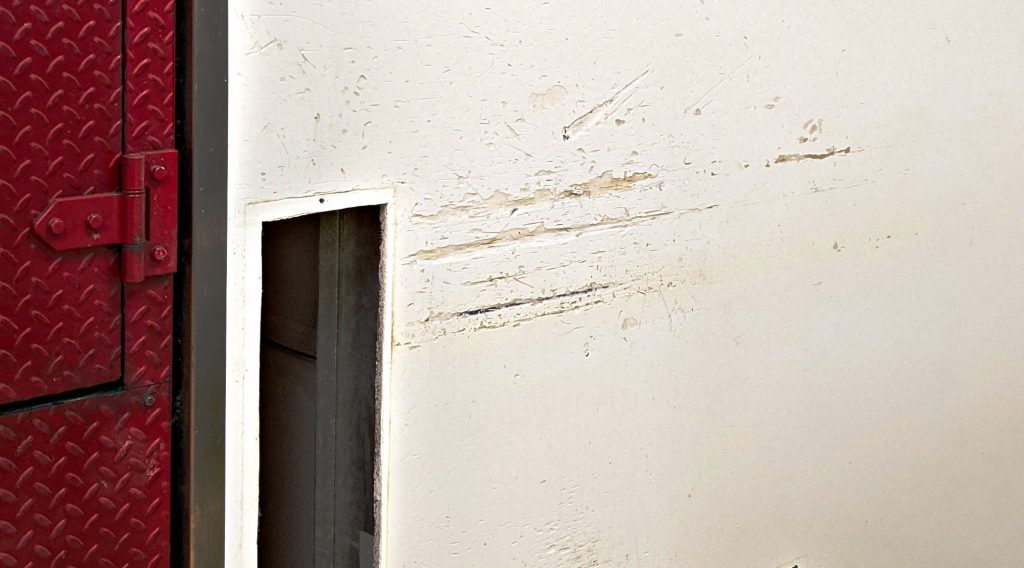
Our final bigger project that we attacked during this pause in regular operations was installing new FRP (fibreglass-reinforced plastic) panels on our kitchen walls. We had originally wanted to have FRP on all the kitchen walls, but we ran out of time and money to do so before we opened the first time. In less than two years of operations, some of our kitchen walls were getting destroyed from meat slicers, prep tables and other equipment repeatedly bumping them on a daily basis. This broke through the paint and exposed drywall mud and wallboard underneath, which are not sanitary, cleanable surfaces, and not waterproof at all.
Founders Jay and Ty took the time to plan out a phase 1.5 FRP installation to immediately address the problem areas, and to plan out future FRP additions and the required materials. We purchased the panels, cut and installed them over the past few days, fixing all of the major problem areas in one fell swoop!
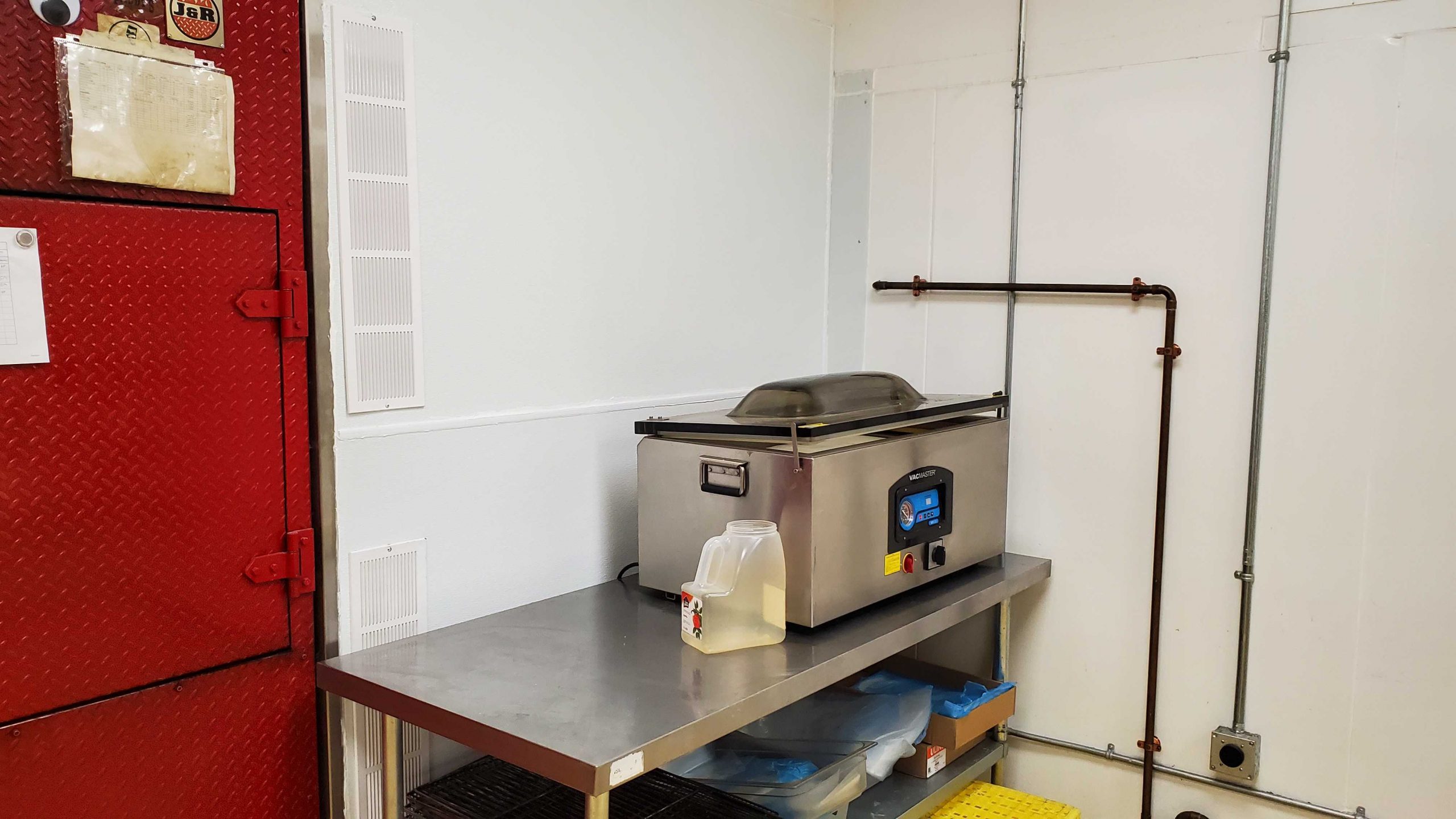
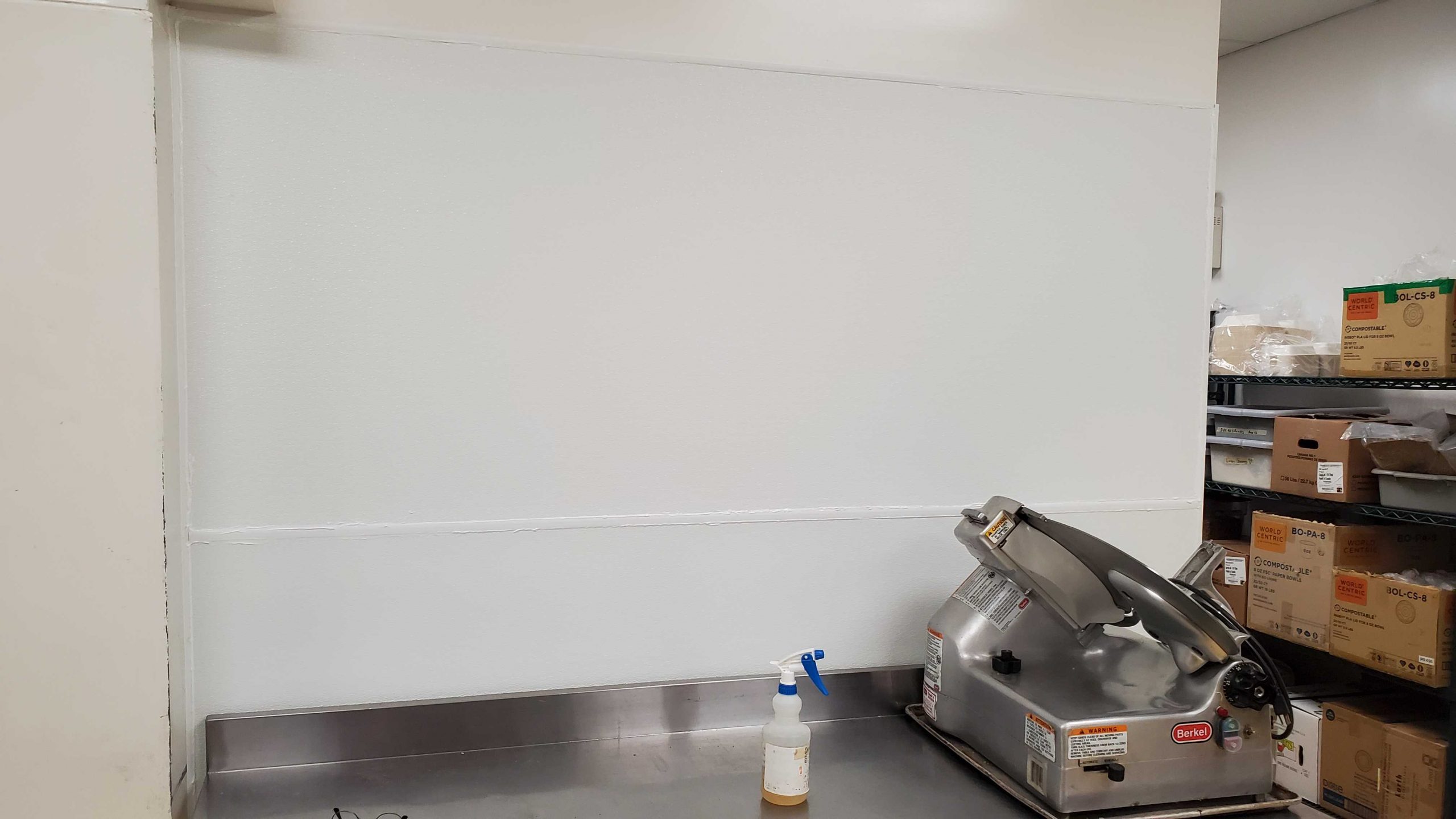
Final Comments – Aerosols
If there’s one final thing we’d like to address, it’s the risk of aerosol-based viral transmission, which was very much top of mind when we wrote Six Frustrating Challenges of Reopening a Restaurant in the Covid-19 Era, an article that went viral and created a huge upwelling of media attention and discussion, including conversations with senior officials in the Alberta government.
In the time since our article came out, there have been dozens of studies focusing on aerosol transmission, with supporting evidence both from real-world case studies and lab-based studies piling up (the Canadian Federation of Nurses Unions has a great page about transmission that they keep updated w/respect to the latest science). China acknowledged aerosol transmission as a likely factor in the Wuhan outbreak in late February, though it was only acknowledged by the World Health Organization in July after hundreds of scientists came forward and publicly pressured them to acknowledge the evidence and stop misleading the public. Also during the time since our article, a brewpub very similar to us, Harper’s Brewpub of Michigan, was linked to a 188-person COVID-19 outbreak. It is impossible to rule out aerosol transmission in many of those cases.
Aerosols are the elephant in the room when health authorities dictate policy, especially when they are talking about crowded places like restaurants or schools. To date, Alberta Health Services has not, to our knowledge, publicly acknowledged the risk of aerosol-based SARS-CoV-2 transmission except during medical procedures, though several of their guidelines do help to mitigate aerosol-based risks. Like the Canadian Federation of Nurses Unions, we believe it best to follow the precautionary principle, which is why we’ve taken measures beyond the AHS guidelines (many of which we don’t have time to list in detail here, but such as minimizing server time at the tables).
Unlike Harper’s in Michigan, one of the coolest things about our facility is that we’ve kept our entire operation open air, without walls or glass separating our patrons from our brewery, and with a massive 38-foot open kitchen pass and large open doorways to the kitchen. In our 12,000-sq.ft. facility, with 20-foot ceilings and very few walls, aerosols have a huge amount of air volume (over 200,000 cu.ft.) to diffuse into, dropping the concentration of true aerosols to minuscule levels, with the transmissibility of airborne viruses being heavily influenced by the amount of viral particles people are exposed to over time.
Even better, our on-site brewery and massive wood-fired barbecue pit forced our engineers to add massive air replacement (makeup air) to our facility design. Our entire air volume is replaced in less than 45 minutes by the combination of our makeup air unit, kitchen hood vents, two large rooftop HVAC units, and several other high-volume exhaust fans. So we are very likely close to on-par with outdoor spaces in terms of risk level from aerosols (which is to say, the risk should be near zero except for those people seated extremely close to an infected super-spreader, at the same table). We can think of no other operating restaurant or bar in Calgary that has either the airspace or the air replacement that we have at Prairie Dog Brewing, so we feel quite confident that if we follow the AHS guidelines, along with our own specific mitigation efforts and sanitary practices:
- Our risk of staff infection from customers is extremely low; and
- The risk of customers from one party infecting those at another is also extremely low; and finally
- The risk that an infected staff member could infect customers is also extremely low.
If you agree, please show us by booking a reservation and/or coming out to visit us for dine-in or a quick beer at the bar on or after August 24th! We’re a great place to reconnect with your cohort and we’ve stocked up all our tanks with fresh beer, just for you!
